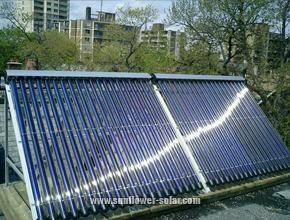The solar thermal circulation
Author:None
From:None
Post time:04/12/2012
View:2756
Within the solar heat, circulation, will be transported by the collector to the hot-water heat. To minimize heat loss, the distance from the collector to the store should be as short as possible.

Within the solar heat, circulation, will be transported by the collector to the hot-water heat. To minimize heat loss, the distance from the collector to the store should be as short as possible. Systems, in one or two single family houses, copper pipes with a range of 15 mm to 18 mm sufficient to ensure an optimal heat transfer. The tubes are sufficient with 30 mm of isolation. For pipes with a diameter of 30 mm, the insulation should be at least the same thickness as the tube. The insulation must be able, withstanding high temperatures, and the outdoor section must be UV and weather resistant. Mineral wool, polyurethane pipe shells, foam: The following materials are used as insulation.
Brackets and safety features in the solar circuit
Common flow rates in small solar systems amounted to 30 to 50 litres per hour per m2 collector area. The solar circulation pump must be able to ensure this flow rate. As a general rule, sufficient conventional pumps with an electrical power of consumption between 40 W and 80 W. Also, the pump should be fitted in the colder outlet of the solar circuit. In this way the pump will be suspended not high temperatures during operation. Finally, shut-off valves are made and mounted behind the pump is a defective pump, so that the whole system not be emptied during the Exchange.
The typical operating pressure of solar systems, which can be controlled by a pressure gauge is located at about 4 bar. The safety valve should be on one about 0,3 bar set pressure to open. Can the heat-conveying liquid with a collection tank caught and then again in the solar cycle of one of the cocks drained to refill. Thermometer in the pre-and return will be used to verify the operation of the system. To prevent the loss of heat from the tank due to inadequate exposure to sunlight or at night by convection (the heat-conveying liquid cooling in the cold collector, and by the force of gravity, then circulates in the direction of memory), a rebound valve mounted in the outlet. The expansion tank keeps the pressure in the system stable and takes the volume changes of the heat-conveying liquid which is caused by the temperature difference. For security reasons the volume of Lengthes sufficiently large is his. It should be able to the entire volume of the heat-conveying liquid. The vent valve is used to deflate the solar circle, after they have been filled with heat-conveying liquid. It is to be mounted on the highest part of the solar circuit.
The Regulation
Often, a simple temperature difference control for which is enough to regulate a small solar system for hot water. Through the use of two temperature sensors the controller determines if the temperature in the collector discharge higher than the temperature of the solar heat exchanger in the tank, and then sets the circulation pump. To start the pump, usually the solar controller is calibrated so that the necessary temperature difference between collector and storage is between 5 ° C and 8 ° C. Is this temperature difference drops to 2 ° C to 3 ° C, then the solar controller turns the solar circulation pump.
Proactive planning for building construction
If you build or renovate a House, but can always still not decide on a solar system, just remember that the preparations for the subsequent installation of a solar system can be performed during the construction phase (guided tours for two copper pipes 18 ' and a five-core cable of the heating area up to the roof). This saves a lot of work and money you later.
Text and images courtesy of the used
German section of the international solar energy society (ISES)
Concise and understandable explanation of the basic concepts in solar thermal and photovoltaics in our solar dictionary you will find.
Reports on technology, economics and politics as well as presentations on innovative systems and products are found in the solar magazine